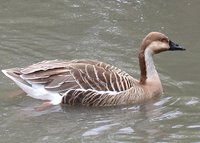Swan Goose
|
|
| Swan Goose Conservation status: Endangered | ||||||||||||||
|---|---|---|---|---|---|---|---|---|---|---|---|---|---|---|
 | ||||||||||||||
| Scientific classification | ||||||||||||||
| ||||||||||||||
| Binomial name | ||||||||||||||
| Anser cygnoides (Linnaeus, 1758) |
The Swan Goose, Anser cygnoides, is a large goose breeding in Mongolia and eastern Russia. It is migratory and winters mainly in south and east China where it is familiarly known as the Chinese Goose, and has been domesticated for centuries.
It has a long neck, long black bill, brown cap and pale underparts apart from some belly streaking; the upperparts are brown and the legs are orange. Sexes are similar, although the male is larger, but juveniles are duller. The voice is a loud honking.
This is a rare goose of the steppes and mountain valleys, which breeds near marshes and other wetlands, laying 5-10 eggs in a ground nest.
It grazes on sedges, and rarely swims. It forms small flocks outside the breeding season.
Its population is declining due to hunting.
References
- Wildfowl by Madge and Burn, ISBN 0-7470-2201-1de:Schwanengans
